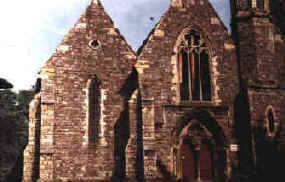"In March 1843, application was made to the Board of Ordnance for a
piece of land to build a church in the Dover part of Hougham Parish, and
the Board generously responded by surrendering nearly an acre of ground,
which had previously been used as a garden, situated between Military Road
and Folkestone Road, the site being chosen near the boundary of St. Mary's
Parish, because the congregation was expected to come from that direction.
The land was given on the condition that there should be space reserved in
the church for 50 soldiers, and a proportionate number of officers.
The money for the erection of the building was quickly subscribed.
The foundation stone of Christ Church was laid on the 2nd of August, 1843,
by the Rev. Thomas Morris, Rural Dean of Dover, Rector of St. James,s and
Vicar of Hougham. Under the stone was placed a list of the
subscribers to the building fund, some coins of the realm then current,
and a parchment, on which was written: 'In the Parish of Hougham,
otherwise Huffam, in the Borough of Dover, in this County of Kent, the
foundation stone of this church, dedicated to our Blessed Lord and Saviour
Jesus Christ, was laid on Wednesday, the 2nd ay of August, 1843, by the
Rev. Thomas Morris, Vicar of the Parish. Trustees: The Venerable
Walter Augustus Shirley, Archdeacon of Derby; John Pemberton Plumptre,
Esq., M.P., of Fredville, in the County of Kent; John Hardy, Esq., 3,
Portland Place, in the County of Middlesex; the Rev. Thomas Bartlett,
M.A., Rector of Kingston, Kent; and Alexander Gordon, Esq., 37, Old Broad
Street, London. Architects: Messrs. Scott and Moffat.
Builders: Messrs. John and Parker Ayers, Dover.' The building of the
Church occupied ten months, the consecration by the Archbishop of
Canterbury (Dr. Howley), taking place on the 13th of June, 1844."
(J.B.J. 1907)
